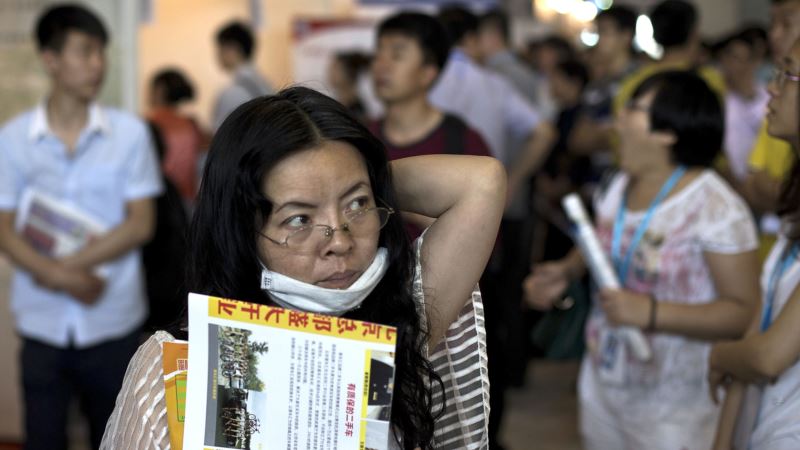The Chinese government says it intends to create 50 million new urban jobs by 2020 and cap unemployment at five percent. But analysts say that while 10 million jobs a year shouldn't be difficult, creating good jobs with satisfying income growth in a slowing economy will be challenging. And keeping unemployment down will be hard as millions of workers in the coal and steel industries are expected to be fired in the coming years, they add. New service-sector jobs emerge Mark Williams, chief Asia economist at Capital Economics, said the goal is reasonable given that China created 64 million jobs during its last five-year period. And new jobs will likely come from domestic demand-related sectors as China gradually moves away from manufacturing, toward a more service-oriented and high-tech economy, he added. “In China’s case, this major structural change is likely to take place over the next few years, so, we’re going to see slower growth in the industries, but faster growth in services. So, that’s really where new jobs are likely to emerge, mainly in the service sector,” the London-based analyst said. In other words, job growth in the newer economy is expected to outpace increases in traditional industries. Labor dispute in new economy But Keegan Elmer, a labor researcher at China Labor Bulletin, expressed concerns over the employment prospects in the newer economy as findings of its latest Strike Map indicated that labor disputes are spreading from the manufacturing sector into new economy-related areas like logistics. Transportation sector protests accounted for 11 percent of the country’s worker actions in the fourth quarter of last year, the labor group found. Actions by drivers of ride apps like Didi and Yidao more than doubled from a year earlier while logistics-sector incidents, including truck drivers, couriers and package sorting hubs, tripled last quarter. All in all, labor unrest in the service sector was the third-worst after the construction and manufacturing industries during the period, it added. That didn’t seem to paint a rosy picture over the Chinese service sector’s future job security or respect for workers’ rights, nor its business viability, the Hong Kong-based researcher said. “It’s a worrying sign that the rights of the workers in their jobs for job security in the newer economy will be hard to come by in the future if some of the same problems [in traditional industries] persist,” said Elmer. A recent survey by Manpower Group’s subsidiary in Shanghai indicated that employers in China have turned conservative and are inclined to delay hiring this quarter, given the uncertainties surrounding Britain's decision to leave the European Union and the election of Donald Trump as president of the United States. Record-high new graduates After China’s economic growth eased to 6.7 percent last year, the weakest expansion in 26 years, the challenge to ensure a steady stream of employment for new graduates is, in particular, daunting especially when the number of graduates continues to reach record heights, with eight million expected this year. Among these new graduates, there’s been discontentment in the quality of the jobs they have landed. And their salary level fell short of their expected increase in living standards, Williams of Capital Economics said. “It will be difficult to generate as rapid income growth as maybe some people would hope for. But a large part of this is simply China becoming more like a normal economy,” he said. That probably explains why a record two million students registered to take the 2016 graduate school admission test in December, rather than preparing to enter the workforce, as many pin their hopes on a higher degree to land better jobs. Local media estimates of the unemployment rate among young college graduates range from four percent to more than 30 percent. Although the credibility of China's official statistics has long been in doubt, Chinese officials claim that the overall unemployment rate has remained at four percent for years, far below the five percent target. Unemployment to worsen The supply-demand gap for skilled workers has already put pressure on the job market while ongoing industrial restructuring will add to concerns over job losses this year. Labor activist Elmer said actual job losses in China may be greater than expected. Businesses supporting those 1.8 million workers in the coal and steel industries, who will be laid off to cut crippling overcapacity, will also suffer. “All of the supporting businesses, restaurants, all of the people, who used to rely on those workers and those salaries coming in… and the knock-on effects really hurt employment prospects that go far beyond the mine or the still mill itself,” he added. To address the challenges, the government has set aside a 100 billion yuan (US$14.6 billion) fund to help laid-off workers from glutted industries apart from an array of pro-employment policies for college graduates and migrant workers. China has further improved its social security system, which is expected to provide flexibility and benefits for people who work outside their hometowns.
Amid Economic Slowdown, China Faces Challenge of Creating Quality Jobs






